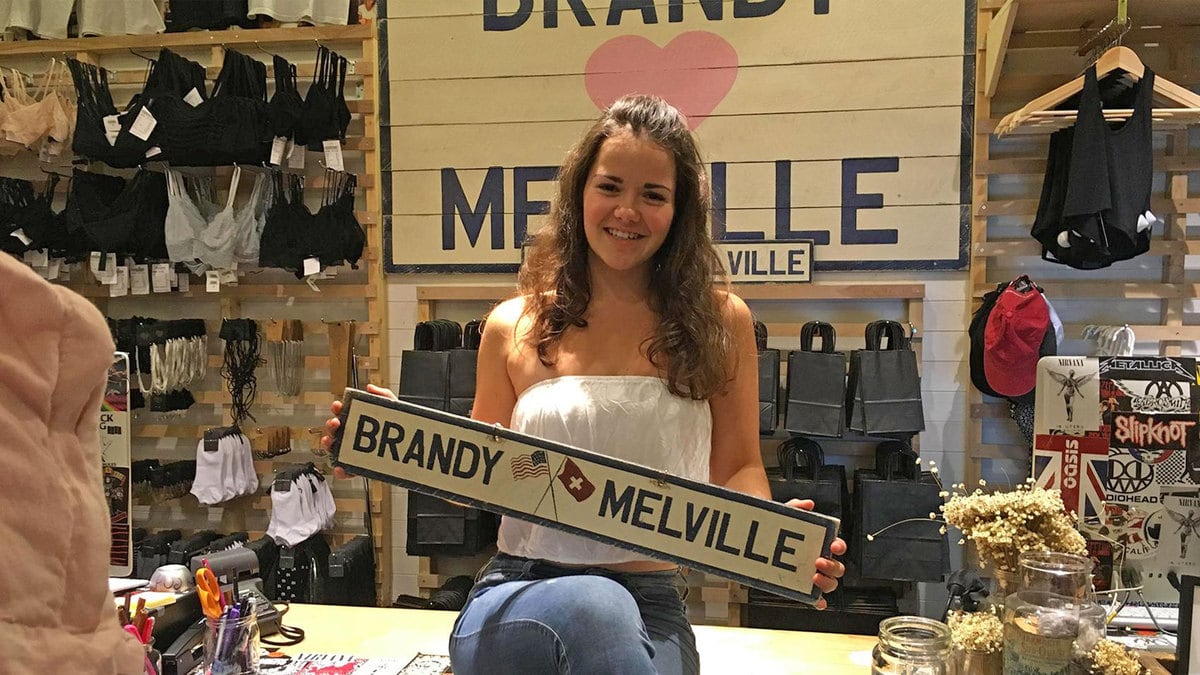A new documentary exposing the hellish landscape of Brandy Melville reports that the male-run company is racist towards non-white employees, steals designs from other stores, and has an obsession with tiny, usually underaged girls. Premiering at the SXSW Film Festival (and airing on HBO later this year), Brandy Hellville and the Cult of Fast Fashion delves into the toxic environment behind the scenes of the California style-themed shop, featuring interviews with both former and current employees, photographers, and former company execs.
Until a few years ago, the CEO of Brandy Melville was nearly untraceable online. Kate Taylor, an investigative reporter at Business Insider who broke the news of Brandy’s poor biz practices in a 2021 bombshell exposé, states that this was one of the hardest details to find as she reported on the company. Google any other business, and their CEO will pop up almost immediately. But if you searched for “Brandy Melville” anytime before 2021, no CEO would appear. Taylor was able to connect the dots to Stephan Marsan, who founded the company but had no digital footprint. For a store that’s entirely based on online aesthetics—skyrocketing in fame on Tumblr, Instagram, and Pinterest—it’s pretty odd to have a CEO with no online presence.
But that’s always been the vibe of Brandy, a handful of employees and, photographers claim, older men—sometimes with braces, sometimes European—who appear out of nowhere and control the entire company. Brandy Hellville features a couple of interviews with former senior VPs who remain anonymous. These guys mostly preach about the company’s success; one celebrates the fact that “Kyla Jenner” and “Ciley Myrus” sported Brandy garb on their Instagram. Other than picking skinny white blonde girls to spotlight the brand, they seem to lack any brand strategy.
Speaking of the skinny white blonde girls, it’s no secret that Brandy has a very specific girl in mind when it comes to its models, employees, and shoppers. The store offers no sizes—all of their tags read “One size fits most”—and its Instagram is chock-full of models as pale as Snow White. In the doc, employees of color recall being shoved to the sidelines at Brandy, being forced to work the cash rap instead of greeting customers at the door. Almost all Black employees were pushed to the back rooms, where they unloaded new clothes in the stockroom, says one former worker. “If you were white,” she says, “you had to be in sight.” Skill did not matter. One employee recalls seeing a co-worker scraping a Swiffer mop around the floor without the actual wet pad attached. As long as you were beautiful, you could work at Brandy.
This brings up the topic of the so-called “Brandy girl”: again, slim and white, blonde or redhead, usually from Malibu or Calabasas or Manhattan, wealthy, and with impeccable style. Employees at the store were asked to recruit any young women who fit this mold. The instructions were as follows: If an employee spotted a “Brandy girl,” they were required to ask for a picture of the girls, who, flattered, would usually comply. Workers would send the photos to Marsan directly, and he would respond to either hire them or let them leave. At the New York flagship store, Marsan had an office with a bird’s-eye view of the floor, and he’d push a button to alert co-workers to take a photo of anyone checking out if he liked their look. One employee caught Marsan flipping through a binder of these images—he kept all of the photos of the girls aged 16-25 to look at forever; God knows why.
Some of these “Brandy girls” got exclusive access to the company. They would be sent on factory trips to Italy and China to try on the clothes and pick what they liked best; they’d get credit cards with unlimited limits to buy clothes at other stores that they liked so that Brandy could copy those garments. Yes: Brandy downright ripped designs from other shops. One former employee recalls a pair of thrifted purple pants she wore to work one day; her manager snapped a pic, sent it to the higher-ups, and a few weeks later, the same pair of pants was on Brandy racks nationwide.
Brandy Hellville spends most of its runtime recounting Taylor’s reporting. There aren’t any huge new surprises—everything massively notable, like the fact that Marsan had a group chat with other Brandy execs where he’d send Hitler and 9/11 memes, has already been reported on. Taylor talks about interviewing a girl who had allegedly been drugged and raped by a man staying at the Brandy Melville-owned apartment in SoHo, the most harrowing detail she learned during her reporting. These details are shocking; however, they’re certainly not news, seeing as Taylor already wrote about all of this in her 2021 report.
We do learn, however, that after the report was published, Brandy sales dipped for a few weeks—and then returned to their usual highs. One of the anonymous Brandy execs recalls Marsan’s internal statement on the matter: All press is good press. Although the words may have been negative, more eyes were on the brand, and Brandy girls never stopped buying new baby tees and skinny jeans. One has to wonder: If that happened after Business Insider’s exposé, will the sales remain consistent after this doc airs?






